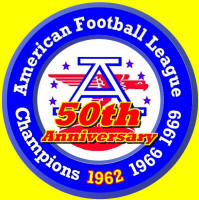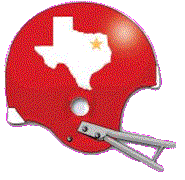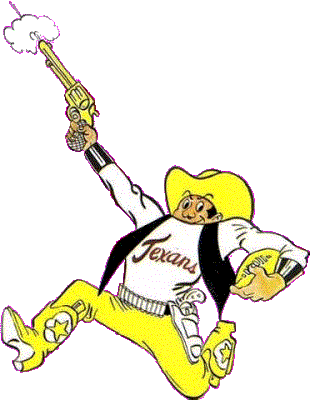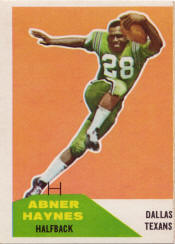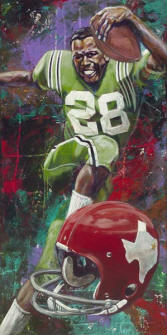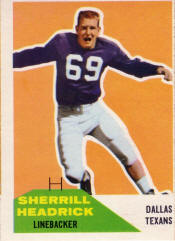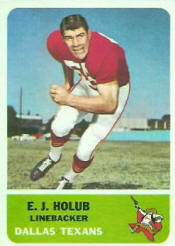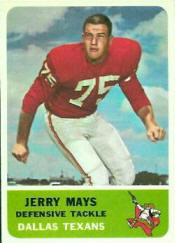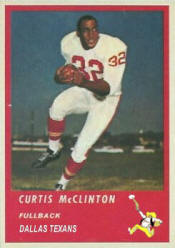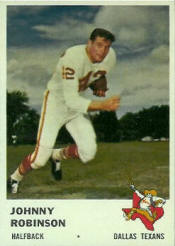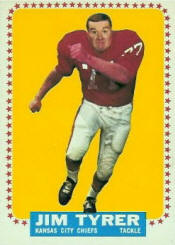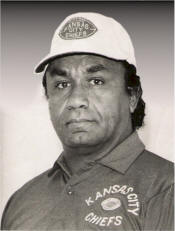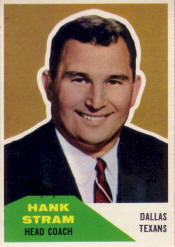|
|
|||||
|
|
|
|
|
||
| . | |||||
The 1962 American Football League Season and the . . .
|
LONGEST
|
|
The Dallas Texans/Kansas City
Chiefs franchise was the flagship team of the American Football League.
Originated as the Dallas Texans by AFL founder Lamar Hunt, the franchise had the most
playoff appearances as an AFL team, six (tied with Oakland), the most American Football
League Championships (3), and the most Super Bowl appearances, playing in the first Super
Bowl, and in the last to be played between LEAGUE champions. On
December 23, 1962 the Texans won the
classic double-overtime American Football League Championship game against the
two-time repeating AFL Champion Houston Oilers, 20 - 17;
the longest, and one of the best
Professional Football championship games ever played.
The Texans/Chiefs had just one coach throughout their AFL history, Hall-of-Famer Hank Stram; and they have the greatest presence in the American Football League Hall of Fame, with 30 representatives, listed below |
|
|
Fred Arbanas Bobby Bell "Buck" Buchanan Ed Budde Chris Burford Len Dawson Tom Flores Dave Grayson Abner Haynes Sherrill Headrick E. J. Holub Clem Daniels Bobby Hunt |
Ernie Ladd Willie Lanier Jacky Lee Jim Lynch Jerry Mays Curtis McClinton Johnny Robinson Paul Rochester Jan Stenerud Otis Taylor Emmit Thomas Jim Tyrer Jerrel Wilson |
|
Hank
Stram Lloyd Wells |
Lamar Hunt Don Klosterman |
. |
. |
ABNER HAYNES |
In 1956 Abner Haynes attended North Texas State University (now the University of North Texas), where he helped make the school one of the first in Texas to integrate its football program. In 1960, Haynes chose to play for the Dallas Texans and led the American Football League in rushing attempts, yards, and TDs in the league’s first year. Haynes helped launch the AFL in 1960, when he was the fledgling league's first Most Valuable Player, and its first Rookie of the Year. He captured the AFL's first rushing crown with 875 yards, and also led the Texans in receiving, punt returns, and kickoff returns. Haynes spent three years in Dallas and two with the Kansas City Chiefs. Haynes still owns 11 franchise records, including most points in a game (30), most touchdowns in a season (19), most touchdowns in a game (5), most career 100-yard rushing games (12), most career rushing touchdowns (39) and most career combined yards (8,442). Over his career he was regularly among the American Football League's top ten rushers, ranking third all-time, and the all-time leader in touchdowns, with 46. He was Hall of Fame head coach Hank Stram's most versatile and dangerous weapon from 1960-62, amassing 43 touchdowns and 4,472 yards on rushes and receptions. In 1962, he helped the Texans win the American Football League championship in the classic double-overtime victory over the defending champion Houston Oilers, scoring touchdowns on a 28-yard pass reception from quarterback Len Dawson, and on a 2-yard run."He was a franchise player before they talked about franchise players," praised Stram. "He did it all - rushing, receiving, kickoff returns, punt returns. He gave us the dimension we needed to be a good team in Dallas." The 6-foot-1, 200-pound Haynes, who had great speed and dazzling moves in the open field, set AFL records with 5 touchdowns in a game and 19 touchdowns in a season in 1961, and with 46 career rushing touchdowns. He also played for the Denver Broncos, the Miami Dolphins, and the New York Jets. During his 8 professional seasons, Haynes carried the ball 1,036 times for 4,630 yards, a 4.5 average; caught 287 passes for 3,535 yards, a 12.3 average, and 20 TDs. |
||
Haynes returned 85 punts for 875 yards, a 10.3 average, and 1 touchdown; and ran back 121 kickoffs for 3,025 yards, a 25.0 average, and 1 touchdown, and ran a recovered fumble back for a td: 69 total touchdowns, for 414 points.His 12,065 combined yards is the American Football League record. Haynes had three games in which he gained 100 or more yards on 14 or fewer carries. He sponsors "Heroes of Football" a program that re-connects pro football players with communities and charities. Abner Haynes is a 2007 inductee to the Texas Sports Hall of Fame |
|||
|
A member of the American Football League Hall of Fame |
||
|
. |
|
An original Dallas Texan out of Texas Christian University, Sherrill Headrick was considered the Texans' and the early Chiefs' best linebacker, a hard-nosed, all-giving player. He left TCU after three seasons and played one season at offensive guard, center and linebacker in the Canadian Football League (1959) before joining the Texans for the initial AFL season, signing as a free agent.His teammates called him "Psycho" for his rambunctious nature, a reputation he fueled by banging his head against his locker and working himself up to the point of nausea before games. The nickname also befit his style of play: in his first year with the Texans, Headrick set the standard for playing hurt, after fracturing a vertebrae in his neck in a collision in warm-ups before a game with the Houston Oilers. Despite pain in his neck, he played the entire game. He learned of the fracture five days later, but went on to play the following week. |
|
|
Hank Stram said that
Headrick, who refused to wear hip pads, had the highest pain
threshold he'd ever seen in an athlete. Headrick payed with a broken
neck, infected gums, and a fractured thumb. When an injury left the
bone in his finger protrding from the skin, he popped the bones in
place without missing a play. Headrick had fourteen interceptions during his eight-year
Texans/Chiefs career, returning three for touchdowns. He
played in the franchise's 1962 and 1966 AFL title game wins and in
the first AFL-NFL World Championship Game. |
|

 |
A
member of the |
. |
In 1961, the Dallas Texans drafted TEXAS TECH Universty's E. J. Holub. A member of the College Football Hall of Fame, Holub started for the Texans and the Chiefs as a linebacker, and as a center.Even after nine knee surgeries, Holub was a leader, a "holler guy". And he was a team player, enduring pain to lead his team. He would spend hours in the training room, watching blood and liquid drain from his knee, then go out to the field and perform as though he was physically "100 percent". He was an American Football League All-Star in 1961, '62, '64, '65 and '66 and was the only player to start two World Championship games at two different positions. He started Super Bowl I at linebacker, then started Super Bowl IV at center and was a driving force in helping the Chiefs run past Minnesota 23-7. |
|
  |
A member of the American Football League Hall of Fame |
|
. |
|
Frank Jackson played collegiately at SMU, and professionally with the American Football League's Dallas Texans, Kansas City Chiefs, and Miami Dolphins. As a halfback in 1961, he scored four TDs (two rushing, two receiving) for the Texans in a 49 - 21 victory over the Denver Broncos. As a wide receiver, in 1964 he caught four touchdown passes from Len Dawson in a 49 - 6 Chiefs defeat of the San Diego Chargers. That tied the Pro Football record at the time. He was an American Football League All-Star in 1965. He played on the Texans' 1962 AFL Championship team, winning the longest pro football game ever played up to that time in the AFL Championship game against the two-time defending AFL Champion Houston Oilers. |
|
|
|
. |
In 1961, in the fifth round, the Dallas Texans also drafted Jerry Mays of Southern Methodist University, where he had been a co-captain and an All-Southwest Conference defensive tackle. Mays was drafted by the Vikings, but chose to play in the AFL, near his home. He was a force at end on the Chiefs' vaunted defensive line, after starting his professional career playing defensive tackle.A six-time AFL All-Star, Jerry Mays was selected to the All-Star team at two different positions: at defensive tackle in 1962 and 1964, and at defensive end in 1965 through 1968. An emotional, durable competitor wth speed, agility and strong "second effort", Mays played in 126 straight games for the AFL Texans and Chiefs, and once recovered and returned a Jets' fumble 58 yards for a touchdown. He was not only an Amrican Football League player but also an AFL fan. |
|
| Mays empathized with Titans players when their paychecks were late and celebrated with Broncos players when they burned their infamous vertically striped socks. Mays is a member of the American Football League All-Time Team. | |

 |
A member of the American Football League Hall of Fame |
. |
Halfback Curtis McClinton was a future choice by the New York Titans in the
14th round of the 1961 AFL draft, from the
University of Kansas, where he is in the school’s Athletic Hall of
Fame. His rights were traded to the Dallas Texans, where McClinton
became one of the early stars of the American Football League.
He was named the
AFL Rookie of the Year in 1962, when he had 604 Yards on
111 carries for a 5.4 yards per carry average, and caught 29 passes for 333
yards. He finished the season off with his selection as the Outstanding
Player of the 1962 AFL All-Star game. |
|
|
McClinton played in two AFL-NFL World Championship games, the first, in which he was the first AFL player to score a touchdown, and the last, in which the Chiefs defeated the Vikings 23-7. He is a member of the Chiefs Hall of Fame. |
|
|
A member of the American Football League Hall of Fame |
. |
|
||
|
Five times the interception leader on the Texans/Chiefs, Robinson redefined the role of the safety in professional football. Opposing quarterbacks soon learned to keep the ball away from him. In 1968, Pro Football Weekly selected him to its combined all-pro team, and Robinson is a member of the All-time All-AFL Team and one of only twenty players who were in the American Football League for its entire ten-year existence. He founded and operates Johnny Robinson's Boys Home in Monroe, Louisiana. |
||

 |
A
member of the American Football League Hall of Fame (click photo to enlarge >) (click here for a story about the photo) |
 |
. |
Jim Tyrer was an All-American at OHIO STATE under Woody Hayes. Signing with the Dallas Texans in 1961, he set the standard for his position.The best offensive tackle of his time, Jim Tyrer anchored the Texans/Chiefs line for 13 seasons. He was an American Football League All-Star seven times, in 1962, '63, '64, '65 , '66, '68 and '69. His blocks were crushing, and his consistent, outstanding play landed him a spot on the American Football League All-Time Team. He had an uncanny ability to open a hole for Chiefs running backs, which helped the team crush the Vikings in the Fourth AFL-NFL World Championship Game. The 6-foot-6, 295 pound giant would single-handedly take on two of Minnesota's vaunted defensive linemen, blow them away and lead the charge as Mike Garrett swept through the hole. Tyrer was named 1969 AFL Offensive Lineman of the Year and played in 180 consecutive games for the team. |
|

 |
|
. |
. |
LLOYD
WELLS |
The epitome of the American Football League's enlightened policies towards
recruiting black athletes was Lloyd C. A. "Judge" Wells, a
Texas
Southern University graduate who, while he was a sports
photographer, accomplished the desegregation of fan seating at amateur and
professional events in Houston. |
No less than eight of Wells' recruits made All-AFL during their pro careers. He had a major hand in staffing the Chiefs to enable them to win the Fourth World Championship Game. |
|

 |
A member of the |
. |
|
|
| Stram's recorded comments from that game have
become classics: "Let's matriculate the ball down the field, boys.",
and his assessment of the Vikings' ineffectual play: "You can't do that in OUR
league!" The man who coached the team Stram beat in Super Bowl IV was elected to the "pro football" hall of fame nine years before Stram was admitted. Like those of other AFL pioneers, Stram's contributions to the game helped change the face of Professional Football. He was a ten-year head coach in the American Football League. (Click here for Behr on Stram) |
|

 |
A member of the |
. |
|
||||
| When his team capped off the league's existence with a crushing victory over a hugely favored opponent, it was Hunt who approved the 10-year AFL patch they wore, commemorating the ten years of excellence of the American Football League. For his foresight and perseverance, and for giving them ten years of pure football pleasure, American Football League fans everywhere say "Thank you!" to Lamar Hunt. | ||||
|
||||
 |
|
 |
|
 |
 |
|
|
|
Coniglio Home |
Ange's Page |
Site Index |
George Blowfish |
Chiefs & AFL Stuff |
1965 topps cards |
Players who Belong in the Hall of Fame |
|
| . | |||||||
|
©2003
American Football
League Hall of Fame All rights reserved. Duplicate in any form you
like, if you're an AFL fan. You have the permission of the American Football League Hall of Fame. Please credit/link to: http://www.remembertheafl.com Last revision: 08 May 2013 ~ Angelo F. Coniglio, nospam.RemembertheAFL@aol.com |
|||||||
|
. |
|
|
